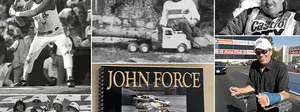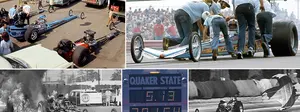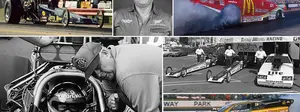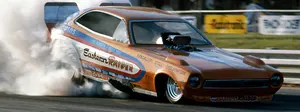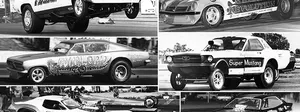

They didn't call him 'Wild Bill' for no reason
|
|
|
|
|
|
 |
|
|
 |
|
|
 |
 Shrewsberry piloted the famed Batmobile during a promotional tour for the TV show. Click here to watch a video of the car in action at Irwindale. |
|
|
Drag racers don’t get nicknames with the word “wild” in them for driving conservatively on the dragstrip, and in three decades of quarter-mile madness, most of it on two wheels, “Wild Bill” Shrewsberry certainly lived up to his monkeyshines moniker.
Shrewsberry is well-known and fondly remembered by Southern California race fans as the driver of the candy-striped L.A. Dart wheelstander that wowed and wheelied its way into our hearts in the 1960s and ‘70s.
The red and white Dodge, nominated by readers of this column for our Favorite Race Car Ever poll, was a mainstay of SoCal tracks such as Irwindale and
I was a big Shrewsberry fan growing up, and, in fact, the L.A. Dart was the first model I ever built. The thing was so outrageous looking -- with a big ol’ supercharged Hemi sticking out of the trunk -- that it looked like something straight out of Saturday morning cartoons.
It took a little bit of searching and the help of another famed quarter-miler, female pioneer Paula Murphy, and her son, Dan, to track down the wild one, who’s now a spry 70 and living in
Shrewsberry didn’t begin as a quarter-mile entertainer but as a serious racer, piloting A/FX entries for the likes of Mickey Thompson and Jack Chrisman. He won class at the 1963 Winternationals in Thompson’s factory-issue Super Duty 421 Lemans and, after Pontiac halted its racing activities later that year, took over the wheel of Chrisman’s first Sachs & Sons Comet, the predecessor to his famous supercharged model, eventually setting the national speed record at 127.53 mph in Inyokern, Calif., and making his first – and only – appearance on a National DRAGSTER cover (May 29, 1964).
Shrewsberry had moved west from his native
“We were in
“I really didn’t think much of it after that, but six weeks later, Hurst called me up and told me to come pick it up. I decided I would go back and check it out, so I went back to their headquarters, which were in
That car, of course, was the legendary Hemi Under Glass (so-called for the ’68 'Cuda huge rear glass), and although the car was intended to be a straight-up race vehicle, it didn’t take Shrewsberry long to discover the car’s true talent.
“I was screwing around with it in the parking lot, the front end kept coming up, so I put some bigger tires on it, and it came right up,” he remembered. “It was never
“We took it to
“Originally the car was carbureted, but it would only go 300 to 400 feet before it got starved for gas, so we put injectors on it, and that solved that problem.”
Hurst originally had planned to run the Hemi Under Glass for one season and had hoped that Shrewsberry would pilot their next experimental machine, the wild Hurst Hairy Olds, but by then, Shrewsberry had already put together a deal for 1966 with the L.A./Orange County Dodge Dealers to campaign a Dodge Dart wheelstander that became the famed L.A. Dart.
“I was in heaven,” he said. “I got a push truck and motor parts and everything. That paint scheme wasn’t really my idea; Dodge colors were red, and they had a [plastic] model of a Dart, which was white. I told them I didn’t care how they painted it."
The first version of the car had an injected engine in the backseat, but the later and better-known cars, including his best-remembered car, the 1970 machine, had a full-race supercharged engine in the trunk for better weight transfer.
“Keith Black told me I should run a blower because I wouldn’t have to work the engine so hard, but I told him I didn’t know anything but blowers, and he said he would teach me everything I needed to know. I had an aluminum KB hemi with magnesium parts, all the good stuff, and a Lenco two-speed with a Crower clutch; a lot of the other wheelstander guys ran automatics.”
Shrewsberry’s trademark move was to drive back toward the starting line after a full-track wheelie and throw the car into a 180-degree spin, then nail the gas as the car was climbing the ring gear right back into another wheelie. The crowd ate it up. He’d also richen the barrel valve to produce flames from the headers and whatever else he could think of. “I did whatever I could get away with,” he admitted.
“Wild Bill’s” wildest stunt was driving his car, in full wheelstand, while standing up through the car’s open windshield area at speeds approaching 120 mph.
“I knew I could do it, and the people went crazy,” recalled Shrewsberry, who braced his right hand on the windshield frame and used his left on the wheel to keep the front tires straight for landing, all the while steering with the brake pedals. “I only got to do it three or four times before [NHRA Event Director] Jack Hart called me into the NHRA offices and told me, very politely, that he knew what I’d been doing and that I couldn’t do it anymore, but to tell everyone I got my ass chewed out really good about it.”
A sleek, Funny Car-style Dart followed in the mid 1970s, and he began the 1980s with a panel wagon truck sponsored by the berry-loving Knott family, of Knott’s Berry Farm (Shrewsberry, obviously, was a perfect fit), but by the middle 1980s, Shrewsberry had had enough of his nomadic life as an exhibition wheelstander driver.
“I just got tired of doing it and had other offers,” he says. “The traveling just kills you. We’d run Great Meadows, N.J., Saturday night and Sunday in
Shrewsberry left the wheelie business and took flight in other ways, as a commercial pilot of Gulfstream jets leased to Warner Bros., whose executives probably would have gotten queasy if they had known about their pilot’s previous antics.
Shrewsberry didn’t limit his driving to wheelstanders. He won class in Indy in 1968 in Sox & Martin’s SS/E and ran a factory ’68 Dart Stocker for engine maestro Black.
He also drove another very famous vehicle, the Batmobile from the famous Batman television series, in 1967.
“George Barris built it and talked to me about driving it, and I drove it for the studio,” he remembered. “It had a good motor – a blueprinted 427 with two fours – and transmission; it was a good car, very lightweight. It ran in the low 12s at 118.”
Still, it will be the famous Dart for which he is long remembered, and fans who saw it in its heyday and those who never did will be able to view it soon when it takes up residence in 2009 in the
“Wally Parks always said he wanted it there,” said Shrewsberry. “Garlits wants it for his museum, Petersen wants it for theirs, but I decided to put it in the
Shrewsberry says he still gets recognized when he attends the NHRA Museum Twilight Cruises with longtime pal Dave McClelland and remembers his time in the spotlight fondly.
“I probably had more fun than the people who watched me,” he told me.
Doubtful, “Wild Bill,” very doubtful.
Blog addendum: I had confessed to "Wild Bill" during our interview about my early model-building efforts with his car and how hard I tried to replicate the stripes using Scotch tape. I guess I wasn't alone because people were selling stripe kits on eBay for a hefty price. "Wild Bill" said he would send me a new kit, a reissue of the original AMT kit produced by Model King, that includes the stripes as decals, as designed by Sean Svendsen and authenticated by Shrewsberry himself, and I said thanks but didn't give it a second thought, never even gave him the address here. Lo and behold, three days later, one arrived. Thanks, "Wild Bill," for everything.
























